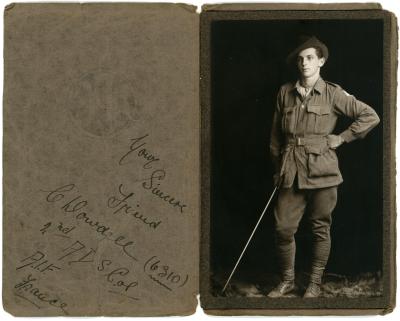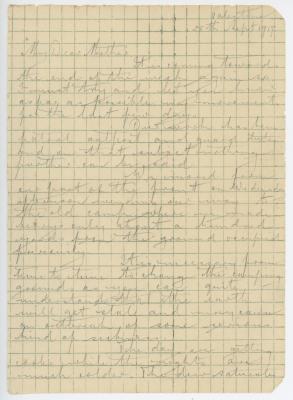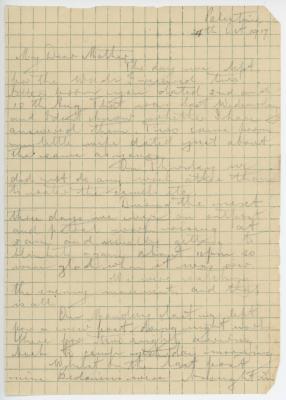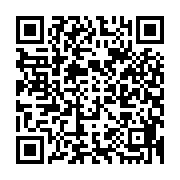First World War Turkish Prisoner of War Crochet Beaded Snake and Lizard
1917A coiled beaded crochet snake covered with green, yellow, red and blue beads accompanied by a beaded lizard of green, pink, white, black and red beads.
The main part of the snake's back is in green beads with a yellow and blue beaded zig zag design. The belly is in white beads. The snake's tail is green. The eyes are beaded in blue and red. The snake's mouth is bordered with red beads, and the inside of the mouth is in plain beige crochet work with a red beaded forked tongue. Under the snake's head is a triangle in blue and green beads and a small line in red beads at the end of the head
'TURKISH - PRISONER' – and a date (likely meant to depict 1917) is worked on the snake's belly in green. There are diamond designs on each side of the writing – two in blue, green and red and one in green, yellow and red
The lizard has an upper body of dark green and pink beads with a lighter green tail and 4 legs. The eyes are black with white surrounds and the mouth is lined with red beads. Underneath is white with an “A” of blue beads.
During Captivity Ottoman (Turkish) prisoners used small glass beads to fashion items such as snakes and lizards, to sell to earn money to supplement their rations and purchase useful items. This beadwork snake would have been made by an Ottoman prisoner of war (POW) in a British POW camp, probably in Egypt. Prisoners were generally not required to work so making craft items helped them pass the time as well as the opportunity to make some money or create gifts for friends or family.
Although many of the snakes produced in the camps have 'TURKISH PRISONER' beaded into their bellies the maker may not have been ethnically Turkish as the Ottoman Empire stretched from the Balkans to the Sinai, and the soldiers in its armies came from throughout the empire.
The snakes usually have a variation of a zig zag design or a diamond design on their backs. The bellies are generally white, often with text beaded in black or dark blue. Occasionally other colours were used. Some have decorative patterns, such as diamonds or triangles between the words on their bellies.
The snakes were made using single stitch beaded crochet. To make them beads had to be strung in order of the design before crocheting commenced. Some of the smaller beaded crochet items could be made with all the beads strung at once. The larger snakes had to be strung and made in sections, fastening the new thread to the worked one as the work progressed.
The snakes were stuffed with whatever materials were available, such as cotton thread, rags, or horsehair to keep their shape. The mouths are plain thread crocheted into two triangles that are attached to the snake. Snakes were amongst the most popular items made and sold. They were considered to bring good luck in parts of Southeast Europe with rituals and superstitions surrounding them, which could be why they were a popular subject. Their shape may have been another reason they were popular with POWs as they are essentially a long tube, which is relatively easy to make in crochet beadwork.
Details
Details
Snake: “TURKISH PRISONER 1917:”
Lizard: “A”
Open in Google Maps
Nearest geotagged records:
- Invalid Cup (0km away)
- Peter Loney Letter (0km away)
- Ellis SILAS Water Colour Painting (0km away)
- Engraved Japanese Water Bottle belonging to Robert George Staunton RENNIE WX7493 (0km away)
- Enlistment Poster (0km away)
- W. D. & H. O. Wills Lace Flag Cigarette Cards (0km away)
- First world War Picture Postcard (0km away)
- Photograph of the Japanese surrender to Australia on 13 September 1945. (0km away)
- Engraved Tin given to Major Arthur Robinson HOME WX11151 (0km away)
- Martini-Henry action (0km away)
Nearby places: View all geotagged records »
Princess Royal Fortress Military Museum
Princess Royal Fortress Military Museum
Other items from Princess Royal Fortress Military Museum
- First World War Photograph of Private Davidson Clyde DOWDELL 6310
- Lambert War Sketches Loan Exhibition 1978-79 Catalogue
- Second World War Shin Gunto (Army Sword)
- Second World War Japanese Imperial Naval Officers Dirk
- First World War Medical Canteen
- Christmas Dinner 1916 menu souvenired by Private Arthur JAMES
- 1954 Eagley Woollen Mills Department of Defence Army Blanket
- 1966 Albany Woollen Mills Department of Defence Army Blanket
- Albany Woollen Mills Wartime Standards Blanket
- 1952 Onkaparinga Woollen Mill Company Department of Defence Army Blanket
- Handwritten Letter from Tpr. Harold (Harry) Endrick MORLEY 2819, to his Mother
- Handwritten Letter From Trooper Harold (Harry) Endrick MORLEY 2819, to his Mother




